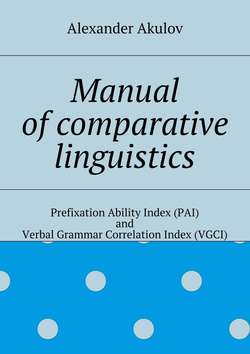Читать книгу Manual of comparative linguistics - Alexander Akulov - Страница 4
2. Prefixation Ability Index (PAI) allows us to see whether two languages can potentially be genetically related
2.1.2. PAI hypothesis development
ОглавлениеHaving got Volodin’s notion about two types of linear model of word form, I for quite a long time thought that there was a pretty strict water parting between languages that have prefixation and those that have not. For instance, I seriously thought that Japanese had no prefixes and tried to consider all prefixes of Japanese as variations of certain roots, i.e. as components of compounds; until one day I finally realized that so called “variations of roots” actually could never be placed in nuclear position and so they all should be considered as true prefixes, so strict dichotomy was broken and I had to elaborate new theory.
As far as any language actually has some ability to make prefixation so there is no strict border between languages with prefixation and languages without prefixation and we should give up ideas of strict subdivision of all existing languages into two sets that have no intersection.
Hence thereupon, linear model of word forms have the following structures:
(P) + (R) + r + (s) – linear model of word form of American type;
(p) + (r) + r + (S) – linear model of word form of Altaic type.
Capital letters are markers of positions that are used more than positions marked by small letters.
Thereby, there is no principal structural difference between languages of American type and Altaic type, difference is in degree of manifestation of certain parameters and so, in order to our conclusion will not be speculative, we should speak about degree of prefixation producing ability / prefixation ability degree / prefixation ability index, i.e.: of certain measure of prefixation.
I suppose that each language has its own ability to produce prefixation and that this ability doesn’t change seriously during all stages of its history.
Also I suppose that prefixation ability demonstrates itself in any circumstances, i.e.: it is manifested by any means: by means of original morphemes existing in a certain language or by borrowed morphemes.
If a language has certain prefixation ability it is shown anyway. That’s why I don’t make difference between original and borrowed affixes.
Also for current consideration is not principal whether this or that affix is derivative or relative: if we take into account relative affixes only, then, for instance, Japanese is a language without prefixes.
That’s why we should define prefixes not by its derivative or by its relative role but by its positions inside word form, prefix is any morpheme that meets the following requirements:
1) it can be placed only left from nuclear position;
2) it never can be placed upon nuclear position;
3) between this morpheme and nuclear can’t be placed any meaningful morpheme with its clitics (i.e.: between nuclear root and prefix can’t be placed a meaningful morpheme with its auxiliary morphemes).
I am specially to note that there are no so called semi-prefixes. If a morpheme can be placed in nuclear position it is meaningful morpheme and any combinations with it should be considered as compounds.
Thus can be resumed the following:
1) Each language has its own ability to produce prefixation and this ability doesn’t change seriously during all stages of its history.
2) Prefixation ability is manifested by any means: by means of original morphemes existing in a certain language or by borrowed morphemes. That’s why the method doesn’t suppose distinction between original and loaned affixes.
3) Genetically related languages are supposed to have rather close values of Prefixation Ability Index.
